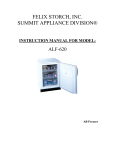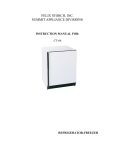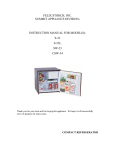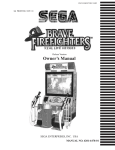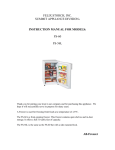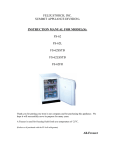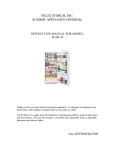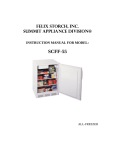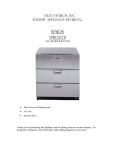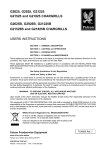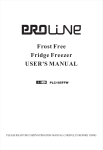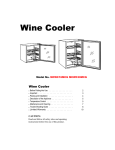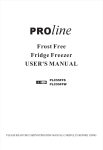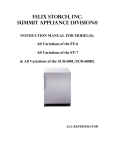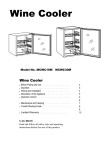Download Summit CP-35 User's Manual
Transcript
FELIX STORCH, INC. SUMMIT APPLIANCE DIVISION® INSTRUCTIONS MANUAL FOR: CP-36R CP-35 CP-35B CP-35LL CP-35BLL Thank you for putting your trust in our company and for purchasing this appliance. We hope it will successfully serve its purpose for many years. A Freezer is used for freezing fresh foods at a temperature of -25°C. A Refrigerator is used for storing fresh foods at a temperature of 32°F and higher. A CP-36 is a unique two door refrigerator with a zero degree freezer. Auto-defrost fresh food section with a manual defrost freezer. This unit has a flush back and is available in white. The CP-35 is the same as the CP-36 but without the flush back. And the CP-35 is available in White (CP-35) and Black (CP-35B) and to add a double lock add the suffix LL to the model number. REFRIGERATOR Before Putting Into Use Before connecting the appliance to the power supply, leave it standing for about 2 hours, which will reduce a possibility of malfunctions in the cooling system due to transport handling. Clean the appliance thoroughly; especially in the interior (See Cleaning and Maintenance). Instructions for Use These instructions for use are intended for the user. They describe the appliance and the correct and safe way to use it. The instructions were prepared for various types/models of refrigerators therefore you may find in it descriptions of some accessories and functions that your appliance may not have. We Care for the Environment Our appliances are distributed in packaging made of environmental friendly material which could safely be recycled, disposed of or destroyed without any effects on the environment whatsoever. Our instruction manuals are printed either on recycled paper or chlorine free bleached paper. Tips for Energy Savings Try not to open the door too often, especially when the weather is hot and humid. Once you open the door try to close it as soon as possible. Every now and then check if the appliance is sufficiently ventilated (adequate air circulation behind the appliance). Set thermostat from higher to lower settings as soon as possible (depending on how loaded the appliance is, the ambient temperature etc...). The coils on the rear of the refrigerator should be cleaned and free of dust or any other impurities. Ice and frost layer increase energy consumption, so do clean the appliance as soon as the layer is 1/8” thick. Always consider instructions stated in sections Positioning and Energy Saving Tips, otherwise the energy consumption is substantially higher. Instructions for Use Use Storing Fresh Foods Foods to be stored in the refrigerator should be properly packed as to prevent mixing various moisture degrees and odors (in polyethylene bags or sheet, aluminum foil, wax paper, covered containers or bottles). Never store any inflammable, volatile or explosive substances. Beverages with high alcohol percentage shall be stored in tightly sealed bottles in a vertical position. Food should not touch the rear wall of the refrigerator. Some organic solutions like volatile oils in lemon and orange peel, acid in butter etc. can cause damages when in contact with plastic surfaces or gaskets for a long period of time. An unpleasant odor inside the refrigerator is a sign that something is wrong with the food or that your refrigerator needs cleaning. Odors may be eliminated or reduced by washing the interior of the refrigerator with a mild solution of water and vinegar. We also recommend using activated carbon filters to clean the air or to neutralize odors. If you plan on taking a long trip make sure you remove all perishable food before you leave to prevent any odors. Fresh Food Storage Time in the Refrigerator Storage time (days) Article of Food 1 2 3 Butter Eggs Fresh uncut meat Chopped meat Smoked meat Fish Marinade Root Cheese Sweets Fruit Prepared dishes + + + + + + + + + + + + + + + = + = + + + + + + Legend: 4 11 12 13 14 + + + + + = = = + + + + + + + + = = = = = = = + + + + + + + + = = = = + + + = = = = = = = = = = = = = = = + + + = = = 5 + + = = = 6 + + = = = 7 8 9 10 + + + + + + = = = = = = = = = = + means recommended storage time = means possible storage time Instructions for Use Commercially Frozen Foods Storage time (months) Article of Food 1 2 3 4 5 6 7 8 9 10 11 12 Vegetable Fruit Bread, Pastries Milk Ready-Made Meals Beef Veal Pork Poultry Game Minced Meat Smoked Sausages Lean Fish Fat Fish Offal + + + + + + + + + + + + + + + + + + + + + + + + + + + + + + + + + + + + + + = + + + + + + + + + + + + + + + + + + + + + + + = + + + + + + = + + + + + = + + + + + + + + + + + + = + + = + + = = Legend: + + means recommended storage time Instructions for Use Important Warning! To reduce the risk of fire, electrical shock, or injury when using your appliance, follow these basic precautions. Read all instructions before using the appliance If you bought this appliance to replace an old one equipped with a lock that cannot be opened from inside (lock, bolt), make sure that the lock is broken. This will make it impossible for children to lock themselves inside the appliance and suffocate. The appliance must be correctly connected to the power supply. If the food has a strange smell or color throw it away because it is very likely that it is spoiled and therefore dangerous to eat. Disconnect the appliance from the power supply before repairing and cleaning it (only a qualified technician should repair it). Use only enclosed tools or tools recommended by the manufacturer. For the sake of environmental protection be careful not to damage the rear wall of the appliance (the condenser unit or the tubes when moving the refrigerator) or any part of the freezing system inside the appliance. Use only enclosed tools or tools recommended by the manufacturer. DANGER: Risk of child entrapment. Before throwing away your old freezer please remove the doors and leave the shelves in place so that children may not easily climb inside. The rating plate is inside the appliance or outside on the rear wall. Disposing of the Worn Out Appliance When your appliance finally wears out, dispose of it. If the appliance has a lock, break it to prevent eventual accidents (danger of children getting locked inside the appliance). Instructions for Use Maintenance and Cleaning Automatic Defrosting of the Refrigerator There is no need to defrost the refrigerator, because the ice depositing on the inner back wall is defrosted automatically. Ice is depositing on the inner back wall during the compressor operation; later on, when the compressor is not operating, ice is defrosting and water drops, collects and drains through the outlet in the inner back wall into the drain pan situated above the compressor where it evaporates. Cleaning the Appliance Disconnect the power supply before cleaning the appliance. Do not use coarse or Aggressive cleaning agents as you can damage the surface. Clean the exterior with water and detergent. Varnished surfaces are cleaned with soft cloth and an alcohol based cleaning agent (for example glass cleaners). You may also use alcohol (ethanol or isopropyl alcohol). The application of abrasive and especially aggressive cleaners, such as stainless steel cleaners, is not appropriate for the cleaning of plastic and coated parts. Remove the detachable accessories in the interior of the appliance and clean it with water and liquid detergent. Plastic parts cannot be washed in a washing machine. Wash the interior of the appliance with lukewarm water, in which you add one or two spoonfuls of vinegar. Every now and then wipe the condenser on the rear wall. Use a soft nonmetal brush or vacuum cleaner. Do not forget to clean the defrost water receptacle above the refrigerators compressor (do not remove the receptacle). After cleaning, connect the appliance to the power supply and reload the packages. Switch Off the Appliance When Not in Use If you do not intend to use the appliance for an extensive period of time set the thermostat knob to the STOP (0) position and disconnect the power supply. Then take out the foods and clean the appliance. Leave the door slightly open. Instructions for Use Trouble-Shooting Guide During the service of your appliance, you can come across some troubles that in most cases result from improper handling of the appliance that can easily be eliminated. The Appliance Fails to Operate After Connecting to the Power Supply Check the supply in the outlet socket and make sure the appliance is switched on (thermostat in the operating position). Continuous Operation of the Refrigerating System The door was frequently opened or it was left open too long. The door is not properly closed (the door may sag; the gasket may be polluted or damaged). Perhaps you have overloaded the appliance with fresh foods. The reason may be inadequate ventilation of the compressor and condenser (assures adequate air circulation and wipe off the condenser). Ice Formation on the Inner Rear Wall As long as the defrost water runs to the channel and through the opening to the drain pan on the compressor, automatic defrosting of the appliance is assured. In case the ice formation on the inner back wall is increased (1/8”), ice should be manually defrosted. Set the thermostat knob to STOP (0) position and leave the door open. Never use electric devices for defrosting and do not scrape the ice or frost layer with sharp objects. After completed defrosting, turn the knob to desired position and close the refrigerator door. The cause of increased ice formation may be one of the following reasons: - the door does not seal well (clean the gasket if it is contaminated, or replace it if it is damaged). - The door was frequently opened or it was left opened for too long. - The food stored in the refrigerator was warm. - The food or dish is touching the inner back wall. Water is Leaking from the Refrigerator In case the discharged water outlet is clogged, or the defrost water drips over the channel, or water leaks from the refrigerator just clean the clogged opening with a plastic straw. Manually defrost the increased ice layer. See “Ice Formation on the Inner Back Wall”. Instructions for Use Noise Cooling in refrigerating-freezing appliances is enabled by the refrigerating system with the compressor, this produces noise. How noisy the appliance is depends on where it is placed, how it’s used and how old the appliance is. During the operation of the compressor, a liquid noise is heard and when the compressor is not operating a refrigerant flow is heard. This is a normal condition and it has no influence whatsoever on the lifetime of the appliance. After starting the appliance, the operation of the compressor and the refrigerant flow may be louder and this does not mean something is wrong with the appliance. The noise will reduce gradually, this will not affect the lifetime of the appliance. Sometimes unusual and strong noises occur which is rather unusual for the appliance. This noise is often a consequence of inadequate placing. To avoid the noise make sure the appliance is placed and leveled firmly on a solid base. Make sure the appliance is not touching the wall or kitchen units standing next to it. And always make sure you check the accessories in the interior of the appliance; they should be placed correctly in their positions. Check the bottles, tins and other vessels that might touch each other and rattle. Before Calling for Service Check the plug and fuse. Test the outlet with a lamp Be sure the control is not set to OFF Read the manual, especially the items under the Use and Care sections. You may find the answer to your questions. If you don’t find the answer to your questions in this manual, find the unit model number (on the upper back of the refrigerator) and contact your Summit Appliance Dealer. Specifications are Subject to Change Without Notice. Instructions for Use








